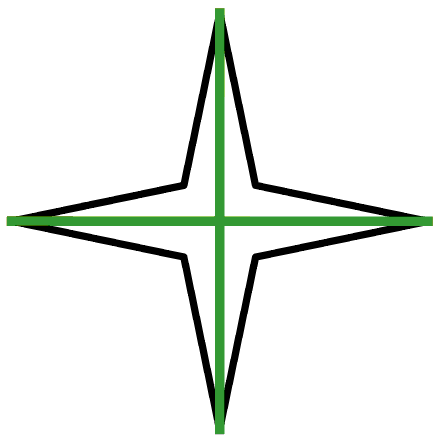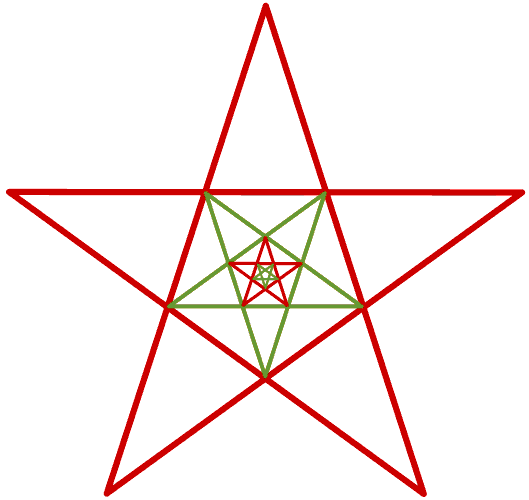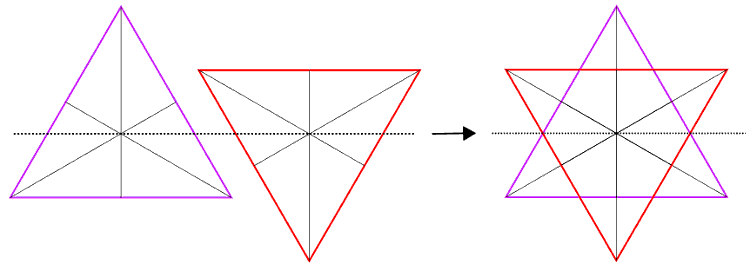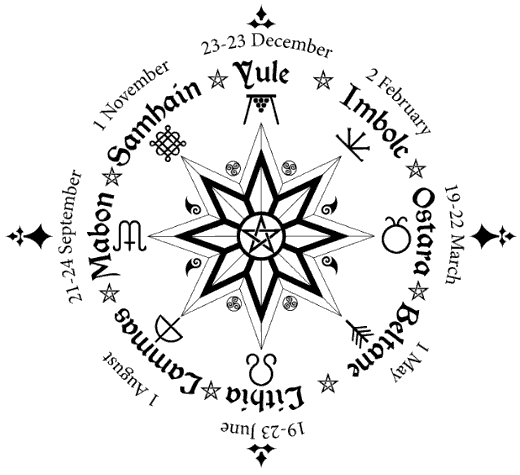
From the ancient Star of Ishtar in Mesopotamia and the Star of David in Judaism to the Rub-el-Hizb in Islam and the Lakshmi Star in Hinduism, star symbols have been found across diverse cultures, civilizations, and religions. They have been used since ancient times to represent various significant and secret aspects of life, the universe, and existence.

In this article, we will explore 10 of the most powerful and ancient star symbols and their deeper meanings. Before diving into these symbols, let’s begin by understanding the fundamental concept of a star and how it is created.
What Are Star Symbols and How Are They Created?
From a geometric perspective, a star (Polygram) is a pattern formed by connecting non-adjacent vertices of a polygon. For instance, a pentagram, (which is a 5-pointed star), is created by connecting non-adjacent vertices of a pentagon, a 5-sided polygon, as shown in the image below.

Sometimes, you can create more than one variation of a star by connecting different vertices within a polygon.

For example, a heptagram (7-pointed star) can be formed by connecting every 2nd vertex within a heptagon (7-sided polygon). This is known as a 7/2 heptagram or 7/2 7-pointed star. Conversely, connecting every third vertex within a heptagon results in another kind of 7-pointed star, called a 7/3 heptagram. This is as shown in the image below.

It’s important to note that stars (or polygrams) have a suffix of ‘Gram’, and polygons have a suffix of ‘Gon’. For instance, the hexagon is a 6-sided polygon, whereas the hexagram is a 6-pointed star.
Now that we have these concepts clarified, let’s delve into the symbolism and deeper meanings of 10 of the most powerful ancient star symbols.
10 Ancient Star Symbols & Their Deeper Symbolism
1. Tristar (3-Pointed Star)
The 3-pointed star, derived from the Triquetra, is an ancient symbol with a presence in various cultures and religions. The Triquetra is constructed by overlapping three circles in a way that each circle’s circumference passes through the centers of the others.

As shown in the image below, the 3-pointed star can be drawn by connecting the vertices of the Triquetra.

Consequently, this star embodies the essence of the Triquetra, symbolizing interconnectedness, the eternal cycle of life, balance, harmony, source energy, creation, light, time, and enlightenment.

It also represents the various triplicities of existence, as in, all important phenomenon in this universe that happen in sets of three. Some examples are as follows:
- Holy Trinity — Father, Son, and Holy Spirit.
- Mind, Body, and Spirit.
- Past, Present, and Future.
- Birth, Life, and Death.
- Creation, Preservation, and Destruction.
- Land, Sea, and Sky.
- Beginning, Middle, and End
- Youth, Middle Age, Old Age
Hence, the three-pointed star stands as a potent symbol, that contains the fundamental workings of the universe at its core.
2. Four-Pointed Star
The 4-pointed star is a powerful symbol that is related to the Celtic Five-Fold symbol and the Witch’s Knot, both of which are ancient symbols found across various cultures and religions. The following image illustrates the 4-pointed star present within the Witch’s knot symbol.

Much like the Five-Fold symbol and the Witch’s Knot, the 4-pointed star represents all important phenomena that happen in sets of four (quadruplicities) and the interconnection that exists between them. Some examples include:

- Four Seasons: Spring, summer, autumn (fall), and winter.
- Four Cardinal Directions: North, south, east, and west.
- Four Elements: Earth, water, air, and fire.
- Four Phases of the Moon: New moon, first quarter, full moon, and last quarter.
- Four Major Solar Events in a Year: 2 Equinoxes and 2 Solstices.
- Four phases in a day: Morning, afternoon, evening, and night.

The star also embodies the concept of creation, as it contains a cross within, as shown in the image below.

The vertical arm of the cross symbolizes masculine energy, while the horizontal arm represents feminine energy. Their point of intersection, which is at the center of the star, symbolizes the source of all creation.
Overall, the 4-pointed star represents interconnection, creation, balance, harmony, the dual nature of the universe, and the eternal cycle of life.
3. Five-Pointed Star
The Five-Pointed star (Pentagram) is an ancient symbol discovered in various cultures and civilizations, including Babylonia, Mesopotamia, ancient Egypt, Greece, and medieval Europe.
The pentagram primarily represents the five elements and the interconnection that exists between them. These elements are Fire, Air, Water, Earth, and the fifth element, Ether or spiritual energy, which is present within all other elements. The Ether element is represented by the topmost vertex of the symbol as shown in the image below:

The meaning of the star changes based on its orientation. When the star is facing upwards, it signifies the victory of spirit (spiritual realm) over matter (material realm) and when it faces downward it signifies the victory of matter over spirit.

Interestingly, you can draw pentagrams within an existing pentagrams infinitely. Also, each inner pentagram reverses its orientation compared to the outer one in which it is drawn. So you get a series of upward and downward facing pentagrams that go on endlessly. This signifies the intricate balance that exists between opposing polarities that is the basis of all creation. It also signifies infinity and the eternal nature of life.
Additionally, the pentagram also represents feminine energy, as it is related to planet Venus. The path followed by Venus as it travels around the sun is similar to that of a five-pointed star.
4. Six-Pointed Star

The 6-pointed star, also known as the Hexagram, is an ancient symbol found in various cultures and religions. In Hinduism, it’s referred to as the Shatkona or the Shiv-Shakti star, in Judaism as the Star of David, and in Islam as the Seal of Solomon.

This star is created by two overlapping triangles, one facing upwards and the other downwards, sharing the same center. The upward triangle represents the Divine Masculine, while the downward one represents the Divine Feminine. The center of the star, shared by both triangles, signifies the source of all creation.
Consequently, the hexagram embodies essential concepts like balance, harmony, interdependence, duality, oneness, and the act of creation.

The star also has another form known as the Unicursal Hexagram. Unlike the regular hexagram formed by separate triangles, the unicursal hexagram can be drawn in a single unbroken stroke, without lifting the hand. This underscores the idea of interconnectedness between the divine masculine and feminine and represents the eternal, cyclical nature of life that continues without end.
5. Seven-Pointed Star

The seven-pointed star, known as the Heptagram, is a symbol rich in diverse meanings across cultures and beliefs. In ancient Babylon, for instance, it represented the seven planets known at that time. These included the Sun, Moon, Mars, Mercury, Jupiter, Venus, and Saturn. These celestial bodies were considered sacred by the Babylonians, and they dedicated a day of worship for each of these planets leading to the creation of a seven-day week.

Thus, the Heptagram symbolizes both the seven days of the week and the seven planets. In addition, it was also used to symbolize the seven sacred metals tied to these planets, which are as follows:
- Gold – Sun
- Silver – Moon
- Iron – Mars
- Mercury – Mercury
- Tin – Jupiter
- Copper – Venus
- Lead – Saturn
In many ancient cultures, the 7-pointed star was used as a protective symbol to ward off evil forces. In Hinduism, the star represents solar energy, symbolizing the seven horses that draw the chariot of the Sun God Surya.
According to the Book of Genesis, God created the world in six days and rested on the seventh. This concept of a seven-day creation is also represented by the seven-pointed star. Given that the universe was completed in 7 days, the 7-pointed star is often seen as a symbol of completeness and perfection.
6. Eight-Pointed Star

One of the most popular stars on this list other than the six-pointed star is the 8-pointed star. Similar to the 6-pointed star, this star has many ancient references and symbolisms. This star can be drawn in 2 different ways as follows:
- 8/2 8-pointed star: This star consists of 2 overlapping squares of equal area that share a common center. This can be drawn by connecting every 2nd vertex in an octagon (9-sided polygon).
- 8/3 8-pointed star:This star is drawn by connecting every 3rd vertex in an octagon (9-sided polygon). It can be drawn in a single stroke and is also known as the unicursal 8-pointed star.
Out of these the 8/2 star that consists of 2 overlapping squares is of special significance as it represents the interconnection between the Divine Masculine and the Divine Feminine and hence is a powerful symbol of creation similar to the six-pointed star.

In Hinduism the 8/2 star is known as the Lakshmi star and represents the 8 different powers of Goddess Lakshmi who is the Goddess of Wealth, Prosperity, and Abundance. These 8 forms are as follows:
- Adi Lakshmi (Goddess of New Beginnings)
- Dhana Lakshmi (Goddess of Wealth)
- Dhanya Lakshmi (Goddess of Agricultural Prosperity)
- Gaja Lakshmi (Goddess of Power and Royalty)
- Santana Lakshmi (Goddess of Family and Progeny)
- Veera Lakshmi (Goddess of Courage and Bravery)
- Vijaya Lakshmi (Goddess of Victory and Success)
- Aishwarya Lakshmi (Goddess of Spiritual and Divine Wealth)
The Rub-el-Hizb which is an ancient Arabic symbol also has the same design consisting of two overlapping squares, The symbol is known as khatim or khatim-sulayman, which means ‘Seal of Prophet Solomon’ and is said to have magical powers.

In Estonia the 8/3 eight-pointed star is considered sacred. Called the Kaheksakand (kaheksa=8 and kand=star) this star is often used as a protective talisman for protection against evil eye and negative energies.

Dating back to 2000 BC, the 8-pointed star is also the symbol of Mesopotamian goddess Ishtar who is the Goddess of love and war. The star was associated with planet Venus which the Mesopotamians considered sacred as the first light to be seen at dawn and the last light at dusk. Hence to the Mesopotamians, the 8-pointed star represented illumination, hope, wisdom, and magic.

Some traditions also associated with 8-pointed star with the Morning Star or the North Star.
In the Wiccan (and many pagan) tradition, the 8-pointed star represents the 8 major solar and seasonal events that occur throughout the course of a year. This includes the 2 equinoxes (Spring Equinox & Autumn Equinox), and 2 solstices (Summer Solstice & Winter Solstice), and the four seasons – Spring, Summer, Autumn, and Winter.

All these events are celebrated by Wiccans. The names of the festivals associated with these events are as follows:
- Yule – Winter Solstice (20 – 23 December)
- Imbolc – Beginning of Spring (1st February)
- Ostara – Spring Equinox (19 – 22 March)
- Beltane – Beginning of Summer (1st May)
- Litha – Summer Solstice (19 – 23 June)
- Lughnasadh – Beginning of Autumn (1st August)
- Mabon – Autumn Equinox (21 – 24 September)
- Samhain – Beginning of Winter (1st November)
In Buddhism, the 8-pointed star is known as the Dharma Chakra and represents Buddha’s teachings and the Noble Eightfold path to enlightenment. Respectively, these are: the right livelihood, the right action, the right effort, the right intention, the right concentration, the right mindfulness, the right speech, and the right view.
In Christianity, the 8-Pointed Star is known as the Star of Bethlehem and is associated with the birth of Jesus Christ. The Three Wise Men are said to have followed this star to find Jesus Christ. As a result, the star symbolizes hope, divinity, miracles, direction, and guidance.
In Chinese philosophy, the 8-pointed star is used to represent the Bagua symbol that consists of 8 trigram. The 8 trigrams are formed by different combinations of Yin and Yang and represent the 8 important natural phenomena (or elements) on earth.
- Heaven (Qian, representing the element of metal)
- Lake (Dui, representing the element of marsh or swamp)
- Fire (Li, representing the element of fire)
- Thunder (Zhen, representing the element of wood)
- Wind (Xun, representing the element of wood or tree)
- Water (Kan, representing the element of water)
- Mountain (Gen, representing the element of earth)
- Earth (Kun, representing the element of earth)
Understanding the eight trigrams of Bagua is believed to give an individual the capacity to grasp the past, present, and future.
7. Nine-Pointed Star
The 9-Pointed star also known as the Nonagram and the Enneagram is a powerful ancient symbol with varied meanings. The star can be drawn in two different ways as follows:
- 9/2 9-pointed star: the 9/2 star is a unicursal star that can be drawn in a single stroke without lifting the pen. This is drawn by connecting every second vertex in a nonagon (9-sided polygon)
- 9/3 9-pointed star: The 9/3 star consists of three overlapping equilateral triangles. It is drawn by connecting every 3rd vertex in a nonagon (9-sided polygon).
Out of these stars, the 9/3 star is of special significance as it is used to represent the 3 important triplicities found in nature that makes existence possible. These are as follows:

- The 1st triangle represents the primal forces of – Creation, Preservation, and Destruction (Re-creation).
- The 2nd triangle represents – Mind, Body, and Spirit which is the basis of life on earth.
- The 3rd triangle represents – Past, Present, and Future, or all of time.
The combination of these triplicities is the basis of all existence. Thus the 9/3 9-pointed star is a powerful symbol of life and creation. It also represents the eternal nature of the universe.
In many spiritual traditions, the 9-pointed star is also associated with completeness, perfection, and enlightenment. This is because 9 is the highest single digit number and hence represents the completion of a cycle.
In Hinduism, the 9-pointed star holds a special significance as it represents the 9 Celestial Bodies, known as the Navagrahas, in Hindu astrology. These celestial bodies include the Sun, Moon, Mars, Mercury, Jupiter, Venus, Saturn, Rahu, and Ketu. Additionally, the star symbolizes the Navaratnas, which are the 9 sacred gemstones associated with these celestial bodies. These gemstones are Ruby (Sun), Diamond (Venus), Pearl (Moon), Coral (Mars), Hessonite (Rahu), Blue Sapphire (Saturn), Cat’s eye (Ketu), Yellow Sapphire (Jupiter), and Emerald (Mercury).
Furthermore, the star is a representation of the 9 forms of Goddess Durga, with each form representing a specific aspect of divine feminine energy.
8. Ten-Pointed Star
Also a powerful ancient symbol, the 10-pointed star (known as the Decagram) is closely associated with the Pentagram (5-pointed star). This star can be drawn in three different ways as follows:
- 10/2 10-pointed star: Drawn by connecting every 2nd vertex in a decagon (10-sided polygon) the 10/2 star consists of 2 overlapping pentagons.
- 10/3 10-pointed star: the 10/3 star is a unicursal star that is drawn by connecting every 3rd vertex in a decagon. This star can be drawn in a single stroke without lifting the pen.
- 10/4 10-pointed star: The 10/4 star is drawn by connecting every 4th vertex in a decagon. It consists of two overlapping pentagrams having the same center.
Out of these, the 10/4 star is of special significance as it consists of two overlapping pentagons one facing upward and the other facing downward. As we already saw, since ancient times, the pentagram has been used to represent the 5 elements. Also, the meaning of the pentagram changes based on its orientation. The top corner or vertex of the pentagram signifies spirit or spirit energy. So when the pentagram faces upward, it represents the concept of Spirit (Spiritual world) over Matter (Material world). When it faces downward, the pentagram represents the concept of Matter over Spirit. This is as shown in the image below:

Thus the 10/4 star represents the perfect balance and harmony that exists between the spirit and material realms. This delicate balance is fundamental for the sustenance of the universe and hence the 10-Pointed star can also be seen as a powerful symbol of creation just like the 6-Pointed Star.
9. Eleven-Pointed Star
In various spiritual traditions, the 11-pointed star is seen as a gateway or portal to higher levels of consciousness and spiritual realms. This is because, in numerology, 11 is considered a master number. It’s associated with spiritual insight, intuition, and enlightenment. The star also represents the concept of duality as the number 11 consists of two ones. This duality represents the balance between opposites and the potential for unity. It reminds us that seemingly opposing forces can come together in harmony, symbolizing the integration of the material and spiritual realms.
10. Twelve-Pointed Star
The 12-Pointed star known as the Dodecagram is another powerful symbol that has been used since ancient times to represent various aspects of life and the universe. The star can be drawn in 4 different ways each with its own unique significance. These are as follows:

- 12/2 12-Pointed Star: The 12/2 star consists of 2 overlapping hexagons. It can be drawn by connecting every 2nd vertex in a dodecagon (12-sided polygon).
- 12/3 12-pointed star: The 12/3 star consists of 3 overlapping squares. It can be drawn by connecting every 3rd vertex in a dodecagon (12-sided polygon).
- 12/4 12-pointed star: The 12/4 star consists of 4 overlapping triangles. It can be drawn by connecting every 4th vertex in a dodecagon.
- 12/5 12-pointed star: The 12/5 star is a unicursal star that can be drawn in a single stroke without lifting the pen. It can be drawn by connecting every 5th vertex in a dodecagon.
The 12/2 star, consisting of two overlapping hexagons, primarily symbolizes the 12 Zodiac signs, categorized into feminine and masculine signs as shown in the image below:

The 12/3 12-pointed star that has 3 overlapping squares represents the 3 important tetrads of physical world as depicted in the image below:

The 12/4 12-pointed star that consists of 4 overlapping triangles represents the 4 important triplicities of existence and the deep interconnection that exists between them.

The 12/5 star, which can be drawn without lifting the pen (unicursally), represents the 12 months in a year and the 12-hour clock. This star embodies the concept of time and the eternal cycle of life.

In Christianity, the 12-pointed star has been used to represent the 12 disciples of Jesus Christ. In Judaism, it symbolizes the 12 tribes of Israel.
Conclusion
These are the 12 most powerful star symbols that have been utilized since ancient times by various cultures and spiritual traditions to represent crucial aspects of life, the universe, and existence. If any of these symbols resonate with you, consider delving deeper into their meanings by drawing them, engaging in meditation or visualization with them, wearing them as symbols, and furthering your understanding through reading and study.






